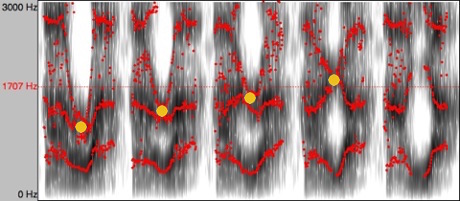Vodka martini – bunched, not curled

Thanks to the global meltdown perpetrated by Wall Street villains in pursuit of world domination, James Bond’s return has been delayed. But at least we now have Daniel Craig in the anglophone remake of Män som hatar kvinnor, aka The Girl with the Dragon Tattoo.
To me, the most distinctive thing about Craig’s speech has always been his bunched-tongue r-sound. Articulatory descriptions of standard English r, or [ɹ], involve the curling of the tongue tip up towards the alveolar ridge or to a point further back. But Craig’s r has a clearer resonance consistent with a bunching of the tongue body and a diminished role for the tongue tip.
Whether Bond’s enemies could use this tell-tale feature to pinpoint the world’s least secret agent, I don’t know. I think it’s quite rare in England, where labial articulations are the most common alternative to the standard apical/postalveolar [ɹ].
Googling “bunched r”, I was led to this post on John Wells’ phonetic blog, which I found somewhat curious. The surprise wasn’t in John’s description of his own r-sound as bunched/molar, but in his further comments:
The strange thing is that it doesn’t sound any different from the postalveolar r sounds that other people use… In my experience, when someone has claimed that there is an audible difference between the molar and the postalveolar kinds, I find that there is also some kind of difference in secondary articulations (pharyngalization, labialization etc), but no audible difference when this is stripped out. That’s why I have some sympathy with the argument that if we can’t hear the difference we don’t need a special IPA symbol for the molar r… Can people actually hear a difference based purely on place of articulation?
For me this brought things full-circle, as the first time I noticed a bunched/molar r was while listening to John as an undergraduate student of his at UCL. I didn’t yet have the bunched/molar terminology at my disposal but, whenever John said the name of a classmate Chris, I could hear that it contained a (labiodentalized) tongue-body affricate of some kind.
And when I first encountered Daniel Craig on the 1996 TV saga Our Friends in the North, I was struck both by his screen presence and by the fact that he had that same bunched r thing as John Wells. Craig’s character, a Tynesider, referred repeatedly to his boss Mr. Barrett:
So it’s been my assumption that curled and bunched/molar r-sounds are audibly different; or rather, that there’s a continuum between the two which is audible, proprioceptively tangible, and visible on spectrograms. This is me making a series of r-sounds between [a] vowels, starting with retroflex, then becoming less curled and more bunched; and I end with the palatal [j]:

The r-sounds all involve the well-known drop in the third formant, F3, so that it more or less meets the second formant, F2 (the formants are the bands picked out by red dots, numbered from the bottom upwards). I’ve shown with yellow dots the meeting-points of F2 and F3. The more curled my tongue is, the lower the meeting-point of F3 and F2; the more bunched, the higher the meeting-point. I would place the r-sounds of Daniel Craig and John Wells roughly between the third and fourth examples; with the formant values of my speech, that would be a meeting-point around 1700 Hz, at least for this vowel context. A few measurements of Craig’s speech suggest that his manly formants are a bit lower than mine. Here’s his Bond:
And his Blomkvist in The Girl with the Dragon Tattoo:
I’m a little surprised that John Wells considers bunched and curled to sound pretty much the same. No doubt many r-sounds hover indeterminately around the middle of my continuum, but not all.
Perhaps the most frequent references to bunched r are in connection with General American, especially its rhotic NURSE-vowel, which is bunched for many but not all speakers. GenAm’s r is often dark in colour, which I attribute to the addition of the pharyng(e)alization and labialization which John mentions to in his blog. (Constriction of the pharynx and protrusion of the lips both tend to enlarge the oral cavity and lower L2.) I particularly associate dark bunched r with women news anchors, whose labialization is often visible.
In contrast to the dark bunched r of GenAm, the famous old New York NURSE-vowel with a palatal offglide (stereotyped in spellings like “doity boid” for dirty bird) surely developed from a bunched rhotic vowel that was near the palatal end of my continuum, ie with a high meeting-point for F2 and F3. Older Hollywood movies often feature speakers with this kind of vowel:
The r-sounds of many Caribbean speakers also strike me as relatively bunched and clear. I’m not sure if it’s a feature of Multicultural London English, but I’ll listen out.
I wonder if there could be some link between John’s r and his Lancashire background? I certainly hear the rhotic r of some Lancastrians as relatively bunched and clear, in contrast to their dark l. Here’s the fictional Fred Elliott from the TV soap Coronation Street:


I found your post very interesting. We found bunched /r/ in an ultrasound tongue imaging study of Scottish English. The speakers in our study who use bunched /r/ are mainly middle class. Some of the speakers who use bunched /r/ in syllable coda, use a tongue-tip raised /r/ in onset, but some bunch in both positions. Other non-middle-class speakers in our study produce /r/ by raising the tongue tip, but there are also timing differences that make these variants sound weakly rhotic and so distinct from bunched /r/. The bunched /r/ of the middle-class speakers in our study has an impact on their vowel system; resulting in centralised and rhoticised vowels in e.g. fir, fur, fern and central prerhotic offglides after close(mid) vowels, e.g. in beer, fair, bore, poor. Interestingly, these centralised vowels have been reported by phoneticians studying middle-class Scottish speech since the early 20th C and these phoneticians explicitly link the occurrence of centralised vowels with the use of a “fricative” /r/ in place of the traditional Scottish trill. Nevertheless, they describe the “fricative” /r/ as a tongue-tip raised /r/. I am very interested in the history of bunched /r/ in British English – how wide-spread is it? how long has it been around? Roger Lass (1983) proposed that bunched /r/ could explain a number of contradictory vocalic sounds changes in historical English and that “the American pharyngealised velar approximant should be regarded as the most likely candidate for the ‘primitive type’ of English /r/.” (p83) I’m not sure I would go this far, but it is possible that bunched /r/ is more widespread in British English than was previously thought. As for how it ended up in Scottish English; it could have come about as part of a natural weaking process, or it may have been adopted from a rhotic variety of RP in the 18th C as Johnston (1985) suggested.
Fascinating – thanks. In connection with John Wells’s post, I’m curious to know if you think you can hear bunched r as well as image it. Or does the “impact” of bunched r on the vowel system mean that there is always another cue to it?
I haven’t read Lass (83) and should do so; I do remember my UCLA teacher Robert P. Stockwell, an authority on the history of English, telling me that the trilled r typically used by modern “performers” of Beowulf can’t be right because it doesn’t account for subsequent sound change.
I bet you’re right that bunched r is far more widespread than generally thought (because general thought constantly falls back on the simplistic Voice Place Manner labels taught in introductory phonetics). So it may be the wrong question to ask how it “ended up” in Scottish English. If there’s no language that contrasts curled and bunched, they’re both probably “ambient” to some degree – available to infants as a means of reproducing the sounds they hear around them.
Could you please elaborate on that Stockwell’s comment. I would really like to know the reasoning behind it.
If you’re a specialist on the history of English, you almost certainly know more about this than I do. If you aren’t, here are the basics from Wikipedia:
A quick search online took me to this poster by Mark J. Jones. He defends the possibility that Old English r was a trill by pointing out that most languages with trilled r only trill it some of the time – so breaking/retraction may have been caused by the non-trilled variants of an r which may otherwise/basically have been a trill.
To me, bunched /r/ has more of a palatal quality than other types of /r/, but the study we are currently undertaking should help us find out whether listeners without phonetic training can perceive bunched /r/. The fact that we have social stratification of /r/ tongue configuration in our Scottish speaker sample tends to suggest that speakers can perceive and reproduce bunched /r/. However, as you say, to what extent are they reconstructing tongue shape on the basis of coarticulatory cues.
To my ear, Bogey’s voice doesn’t sound “old New York” at all: it is distinctly rhotic. I should add that I’m not formally trained, have lived in NYC for thirty years, and was born in New Jersey just outside the NYC isogloss bundle, so I’ve been listening to both rhotic and non-rhotic New-York-area speech for fifty years. I myself have the bunched r, and get weary of being told that “Americans use a retroflex r”.
Thanks for reading and commenting, John. Could you give an example of someone who does sound “old New York” to you? Bogart was certainly not “distinctly rhotic”:
That is to say, he very frequently vocalized his r unless a vowel followed. My understanding is that this was typical of New Yorkers of his age and class.
A separate matter is the NURSE vowel, which for many non-rhotic New Yorkers is (and was) nonetheless r-coloured. It’s common to describe such a vowel as “rhotic” (as I did in my post), which can be misleading. Bogart’s NURSE vowel was of this r-coloured type; perhaps this is what you mean when you describe his voice as rhotic. I definitely hear his NURSE vowel as “a bunched rhotic vowel… near the palatal end of my continuum”. These examples are perhaps better than the one in the post:
I hear this very much as “old New York”, at least the more “educated” variety. The r-colouring is distinctly palatal-ish, and my guess is that it was this kind of pronunciation which naturally developed, in the more progressive (lower class) accents, into the non-r-coloured diphthong [əj] stereotypically described with spellings like “doity boid”.
I realize that the last comment was posted months ago, but I’ve always been so interested in this topic that I’ll post one anyway. I too think that Daniel Craig’s r pronunciation sounds strange, but I think it’s more a result of secondary articulations (or possibly a lack thereof) than of its being bunched, the reason being that I too use a molar r (it’s labio-dentalized when used as a consonant, but my lips are relaxed when I pronounce rhotic vowels). You mentioned that John Wells had an affricate sound in “Chris” (John Wells himself actually made note of this affricated pronunciation of his r after velar stops on his own blog which you referenced), but that could just be his ideolect since I don’t make any such sound in spite of my molar realization of the r phoneme.
It’s funny. Because I and almost everyone around me here in New York’s Hudson Valley use the bunched r, I always assumed that the heavier r sound that you can here in parts of the South and to a lesser degree in the Midwest was the result of heavy retroflexion. On the other hand, a person posted a comment on John Wells’s blog about how she thought she could differentiate the two r sounds because she assumed that the bunching of the tongue was what accounted for the heaviness of the same r sound which I had thought was retroflexed. After playing around with my r’s, I would have to agree with John Wells that any differences in the r sound are really just a result of secondary articulations because I was able to achieve the heavy r sound with both molar and retroflex r pronunciations by pharyngealizing the sounds.
With r, the distinction between primary and secondary articulation easily breaks down. Daniel Craig and John Wells bunch their tongues into a relatively palatal articulation; what’s primary and what’s secondary in that? I think there’s a natural tendency for bunched r to be clear and curled to be dark. Other vocal tract manipulations can counteract, or even outweigh, this. But my guess would be that you can darken a curled r more, and more easily, than you can darken a bunched r.
Edith Skinner’s “Speak with Distinction” has a strong preference for the “bunched r” when the r is a vowel. She prefers this soft r as it has a relaxed quality. I have noticed many actors use the bunched r, for example John Hamm. Odd there is so little written on the subject.
I understand that labial constriction lowers all
resonances of the vocal tract, and constriction at the point 1/3 from the glottis to the lips lowers the second formant, to create back vowels. But the combination of pharyngealization, dorsopalatal constriction, and labialization, constricts the resonant nodes at the 1/5, 3/5 and 5/5 points respectively along the vocal tract half-tube. This articulation precisely lowers F3, but not F2, and so enhances its merger into the F2F3 superformant of ideal cardinal R.
(In contrast to the F1F2 superformant merger of ideal cardinal /a/ and back vowels)